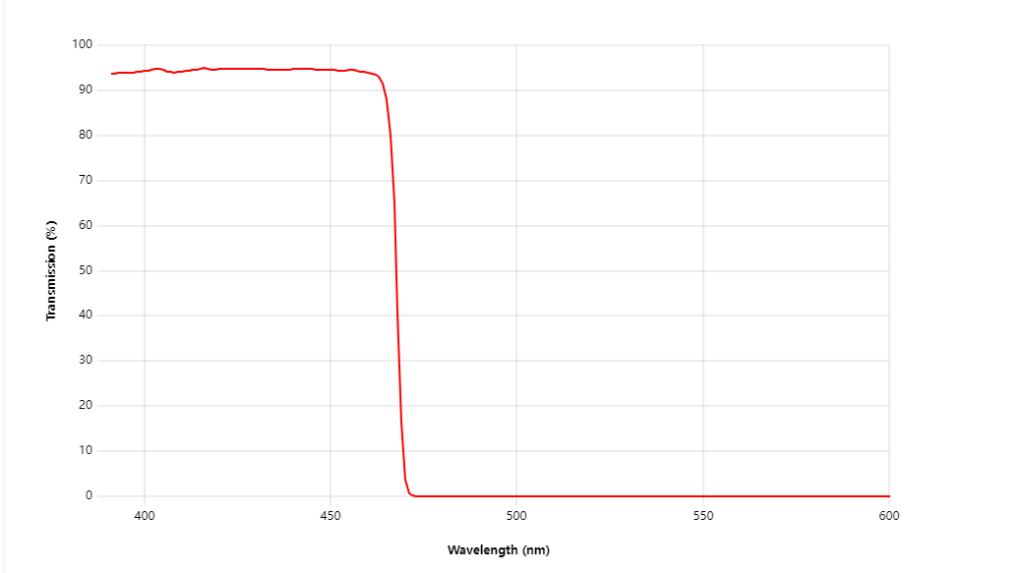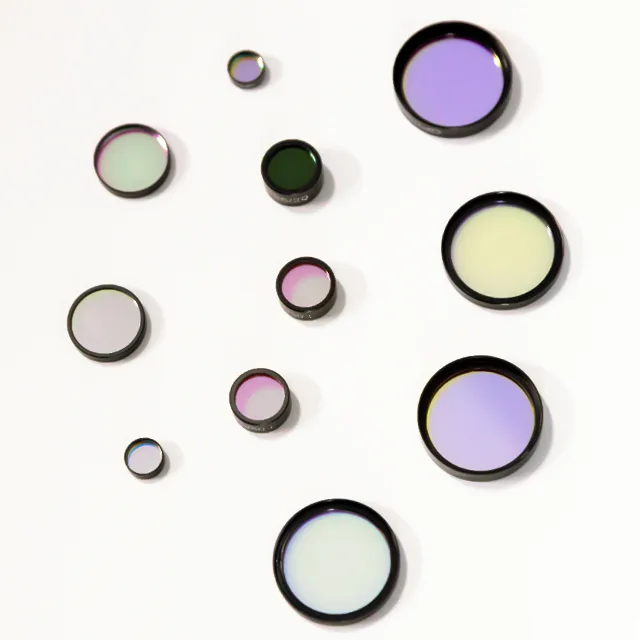Optolong’s short-pass filters facilitate countless applications by selectively blocking longer wavelengths and transmitting shorter wavelengths. These filters help enhance image contrast and clarity in photography, scientific research, and industrial imaging applications and are widely used in various fields such as biomedical imaging and machine vision.
This article will detail the main features of 5 popular short-pass filters from the Optolong website to help users choose the right product for their specific needs.
Shortpass Filter 370nm
Shortpass Filter 370nm is a high-performance filter designed for extreme UV imaging. It can effectively block light waves above 400nm and is particularly suitable for scientific research and high-precision UV imaging needs.
Its high transmittance and strict wavelength control provide users with imaging clarity and accuracy, making this filter an ideal choice for any extreme UV imaging solution.
Features
- Blocks UV and infrared from 400nm to 1100nm
- Transmits more than 90% of light waves below 370nm
- Uses high-quality hard coating to enhance durability and performance
- More than 90% transmittance ensures image brightness and clarity.
Shortpass Filter 470nm

Optolong Shortpass Filter 470nm is specially designed to transmit wavelengths below 470nm, mainly blocking UV and infrared outside the 700nm edge wavelength, and only transmitting visible light, which is particularly useful in photography and astrophotography to prevent haze and improve image clarity.
Features
- Blocks UV and infrared from 735nm to 1100nm
- Transmits more than 85% of visible light
- Adopts hard coating to improve durability and performance
- Improve photo quality by reducing unwanted spectral noise
Shortpass Filter 510nm
Shortpass Filter 510nm is a filter specially designed to accurately isolate light at wavelengths of 510nm and below, suitable for various applications that require enhanced imaging clarity in the green light band, such as bioluminescence imaging and certain types of scientific experiments.
With its excellent performance and reliable optical properties, this filter provides users with clear and precise visual effects and is an ideal choice for scientific research and medical fields.
Features
- It can effectively block infrared light between 520nm and 1100nm, and focus on transmitting green light below 510nm.
- More than 88% transmittance ensures the brightness and color authenticity of the image.
- Enhanced coating to improve scratch resistance
Shortpass Filter 630nm
A Shortpass Filter of 630nm is very suitable for astronomical and geographic photography. It can effectively improve the imaging quality of the red spectrum region while blocking light beyond 630nm wavelength.
This filter combines excellent optical properties and high transmittance to provide users with clear and accurate image output.
Features
- Blocks infrared from 640nm to 1100nm
- Transmits more than 80% of light waves below 630nm
- Advanced coating technology is used to enhance the durability and performance of the filter
Shortpass Filter 700nm
Shortpass Filter 700nm is a high-performance filter that can accurately control the near-edge wavelength of infrared. It can effectively transmit light waves of 700nm and below.
Particularly suitable for applications that require fine processing of visible light close to infrared, such as geological and plant imaging, and other scientific and industrial fields where spectral resolution is strictly required.
Features
- It can effectively block infrared light between 710nm and 1100nm, ensuring that only light waves of 700nm and below are transmitted, thereby improving the accuracy and contrast of imaging.
- Providing more than 80% transmittance, ensuring that the image remains clear and bright while receiving sufficient light.
- Enhanced durability and anti-interference coating enhance the durability and protection of the filter
Optolong Short Pass Filters

In Optolong’s short-wave pass filter series, each filter is designed to meet specific optical needs, providing more than 80% visible light transmission while effectively blocking UV and infrared. Whether it is scientific research or high-precision imaging, Optolong’s short-wave pass filters provide excellent image quality and precise spectral control.
Choosing the right filter can not only enhance the imaging effect but also optimize the transmittance of specific applications, ensuring the clarity and color accuracy of the final image. Please contact us for an accurate quote! Choose the right filter for your application.
FAQ
How to choose the right Shortpass Filter?
The following factors need to be considered when choosing the right Shortpass Filter:
The maximum wavelength to be blocked: Determine the wavelength range of light waves that need to be blocked according to your application.
Transmittance: High transmittance can ensure that more light passes through the filter and improves the imaging brightness.
Durability: Especially when working in harsh environments, choose a coated filter with high durability and resistance to environmental interference.
What should I pay attention to when using a Shortpass Filter?
When using a Shortpass Filter, you should ensure that the filter is properly installed and that its operating wavelength range matches the application requirements.
At the same time, the cleanliness and integrity of the filter should be checked regularly to avoid dust and scratches that affect the imaging quality.
What is the difference between long-pass and short-pass filters?
Longpass filters transmit light with wavelengths longer than their cutoff point and block light with shorter wavelengths, making them ideal for applications that need to filter out shorter wavelengths.
Shortpass filters do the opposite: they transmit light with wavelengths shorter than their cutoff point and block light with longer wavelengths, making them ideal for applications that need to filter out longer wavelengths.
Essentially, long-pass filters allow long-wavelength light to pass through, while short-pass filters allow short-wavelength light to pass through.
Related reading: Long pass and short pass filters
